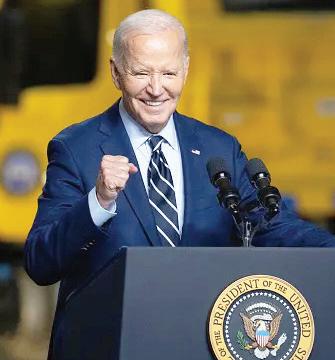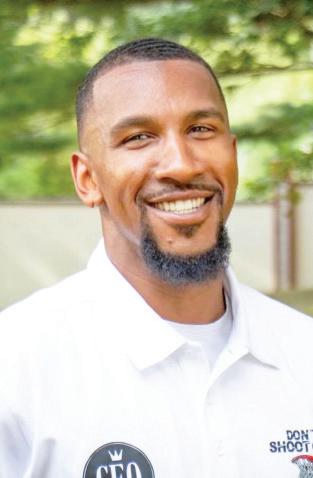
5 minute read
New Biden rule means healthier water for Black communities
EPA mandates water companies nationwide dig up and replace lead pipes
By Jennifer Porter Gore
ead-contaminated drinking water is a long-known health hazard that can cause developmental problems in children and health issues in adults. But many households still get their drinking water from utilities that use lead pipes — especially in Black communities.
A decade after the Flint, Michigan water crisis made national headlines, the Biden administration finalized a landmark rule this month requiring water utilities nationwide to locate and replace all lead pipes in their infrastructure systems by 2034. Speaking at a public works field office in Milwaukee, President Joe Biden called the new rule an overdue environmental justice win for underserved communities, which he said had “borne the brunt of lead poisoning for damn too long.”
The Lead and Copper Rule Improvements addresses what is widely known as a major public health threat that is particularly dangerous to infants and children. Lead exposure in public drinking water is a longstanding issue that has disproportionately affected the nation’s Black communities for decades.
Neighborhoods prioritized Along with the new rule, the EPA announced $2.6 billion in newly available drinking water infrastructure funding through the Bipartisan Infrastructure Law. These funds will support lead pipe replacement and inventory projects, and 49% of the funding must go to disadvantaged communities as grants that do not need to be repaid.
The issue exploded 10 years ago when it was revealed that the entire population of Flint, a predominantly Black city, had been drinking water from the Flint River pumped through lead pipes. The scandal erupted when scores of residents complained that the foul-smelling, discolored water was causing skin rashes, hair loss, and itchy skin.

Speaking at a public works field office in Milwaukee, President Joe Biden called the new rule an overdue environmental justice win for underserved communities.
The issue has still not been
‘Bringing Hope to the City’ Gala raises funds to end gun violence
By Cynthia Moothart Managing Editor
ommy McBrayer Jr. understands the impact of gun violence.
Home from college in 2010, he started selling marijuana to make money and get off friends’ floors and couches.
After a drug deal turned violent, McBrayer was tied up, shot, and left for dead.
“That was an eye-opener for me,” he says. “I knew I had to get on a different path.” McBrayer became a community organizer with CANDO, the Central Area Neighbor- hood Development Organization, which seeks to build an urban landscape that heals, not harms, by eliminating systemic oppression. He also began hosting a Thanksgiving dinner, a free gathering in his apartment that grew into a significant community event held in public spaces. But even a turnaround in life didn’t protect McBrayer from gun violence. Almost a decade after that near-fatal drug deal, McBrayer was shot twice in the belly during an argument with an intoxicated family friend. The following year, a year in fully resolved. Two years later, authorities found record levels of lead in the drinking water of
■ See WATER on page 5

By Alexzia Shobe Staff Writer
innesota is at a critical juncture of reconciliation.
In the wake of George Floyd’s murder on May 25, 2020, at the intersection of 38th Street and Chicago Avenue in Minneapolis, the area has been transformed by the community into a space offering solace from the pain of shared heartache.
Officially designated as George Perry Floyd Square, the intersection became a focal point for memorials, protests and dialogues surrounding systemic racism and police brutality. The city prepares to unveil its plans for redeveloping the square at a dinner dialog on Oct. 29.
Since March, the city has collaborated with the Black-led architectural design firm 4RM+ULA and the Cultural Wellness Center to conduct a series of dinner dialogues and visioning workshops to create a comprehensive blueprint for the square’s redesign.
ity, and respect for the social movements that emerged from this tragedy. The city’s engagement goals are multifaceted. They include allowing for racial healing, fostering community relationships, and ensuring that the redesign reflects the needs of local residents. Feedback gathered from community stakeholders noted the need for economic vitality, safety improvements, and spaces that encourage gathering and reflection.
As the city moves forward, key design principles have emerged, focusing on creating a sacred space. Notably, officials have stated that there will be no vehicular or transit access to the exact location where Floyd was murdered—reinforcing the square’s status as a memorial site.
“George Floyd Square is a place of profound significance for our city, and its development will reflect our commitment to community-led transformation.”
Public Works staff emphasized the importance of honoring the voices of Black, Indigenous, and People of Color (BIPOC) communities, stating, “This is a significant opportunity for us all to define the future of 38th & Chicago.”
Community engagement has been a cornerstone of this transformation, with many residents advocating for a redevelopment process that prioritizes healing, inclusiv-
“George Floyd Square has been a dynamic community memorial space since the day George Floyd was murdered,” said Alexander Kado, Minneapolis senior project manager. “Community members and local caretakers have been preserving the memorials by working with artists. Rise and Remember (formerly George Floyd Global Memorial) has led the preservation effort.”
In light of the city’s efforts to reimagine the square, questions remain about the path to repair and forgiveness. Historical precedents, such as memorials for victims of the Vietnam War, illustrate the importance of thoughtful design and community involvement in
■ See GFS on page 5 which Minneapolis registered 98 gun-related deaths, McBrayer founded Don’t Shoot Guns, Shoot Hoops (DSGSH)— a nonprofit committed to ending gun violence. Made up of
■ See GALA on page 5 Tommy McBrayer


